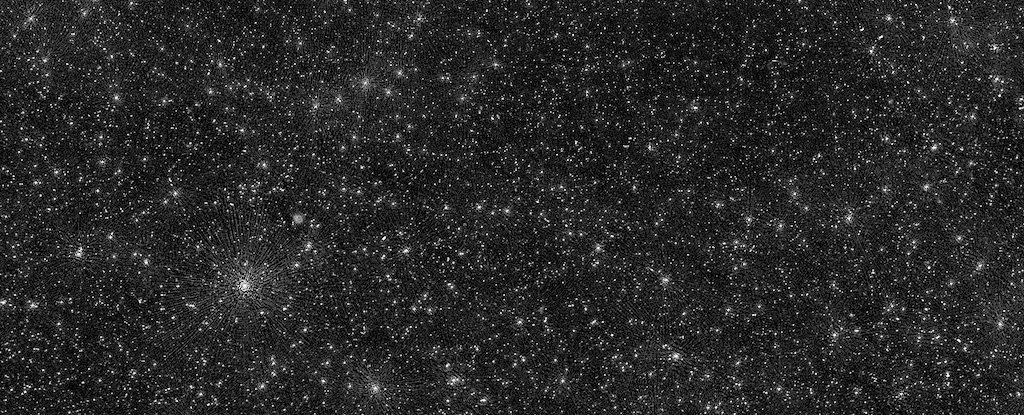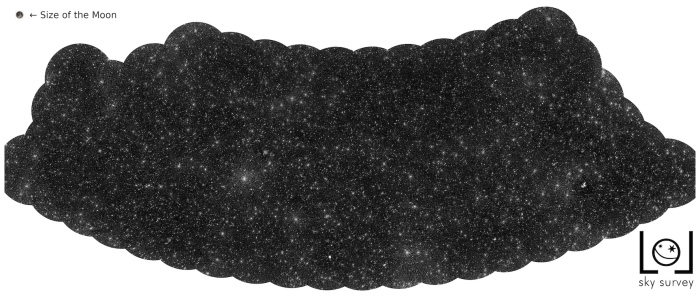
Posted on 01/03/2022 5:56:49 AM PST by Red Badger

(LOFAR/LOL Survey)
The image above may look like a fairly normal picture of the night sky, but what you're looking at is a lot more special than just glittering stars. Each of those white dots is an active supermassive black hole.
And each of those black holes is devouring material at the heart of a galaxy millions of light-years away – that's how they could be pinpointed at all.
Totaling 25,000 such dots, astronomers created the most detailed map to date of black holes at low radio frequencies in early 2021, an achievement that took years and a Europe-sized radio telescope to compile.
"This is the result of many years of work on incredibly difficult data," explained astronomer Francesco de Gasperin of the University of Hamburg in Germany. "We had to invent new methods to convert the radio signals into images of the sky."

(LOFAR/LOL Survey)
When they're just hanging out not doing much, black holes don't give off any detectable radiation, making them much harder to find. When a black hole is actively accreting material – spooling it in from a disc of dust and gas that circles it much as water circles a drain – the intense forces involved generate radiation across multiple wavelengths that we can detect across the vastness of space.
What makes the above image so special is that it covers the ultra-low radio wavelengths, as detected by the LOw Frequency ARray (LOFAR) in Europe. This interferometric network consists of around 20,000 radio antennas, distributed throughout 52 locations across Europe.
Currently, LOFAR is the only radio telescope network capable of deep, high-resolution imaging at frequencies below 100 megahertz, offering a view of the sky like no other. This data release, covering four percent of the Northern sky, was the first for the network's ambitious plan to image the entire Northern sky in ultra-low-frequencies, the LOFAR LBA Sky Survey (LoLSS).
Because it's based on Earth, LOFAR does have a significant hurdle to overcome that doesn't afflict space-based telescopes: the ionosphere. This is particularly problematic for ultra-low-frequency radio waves, which can be reflected back into space. At frequencies below 5 megahertz, the ionosphere is opaque for this reason.
The frequencies that do penetrate the ionosphere can vary according to atmospheric conditions. To overcome this problem, the team used supercomputers running algorithms to correct for ionospheric interference every four seconds. Over the 256 hours that LOFAR stared at the sky, that's a lot of corrections.
This is what has given us such a clear view of the ultra-low-frequency sky.
"After many years of software development, it is so wonderful to see that this has now really worked out," said astronomer Huub Röttgering of Leiden Observatory in the Netherlands.
Having to correct for the ionosphere has another benefit, too: It will allow astronomers to use LoLSS data to study the ionosphere itself. Ionospheric traveling waves, scintillations, and the relationship of the ionosphere with solar cycles could be characterized in much greater detail with the LoLSS. This will allow scientists to better constrain ionospheric models.
And the survey will provide new data on all sorts of astronomical objects and phenomena, as well as possibly undiscovered or unexplored objects in the region below 50 megahertz.
"The final release of the survey will facilitate advances across a range of astronomical research areas," the researchers wrote in their paper.
"[This] will allow for the study of more than 1 million low-frequency radio spectra, providing unique insights on physical models for galaxies, active nuclei, galaxy clusters, and other fields of research. This experiment represents a unique attempt to explore the ultra-low frequency sky at a high angular resolution and depth."
The results have been published in Astronomy & Astrophysics.
A version of this article was first published in February 2021.
PING!......................
We are so small in the universe.
Just tiny little specks about the size of Mickey Rooney.
All these Black Holes and the Astrophysicists tell us there isn’t enough matter in the observable universe to account for the Big Bang, so they ‘invent’ Dark Matter to fill in their formulae. Then they discover that there is not enough ‘energy’ to make the formulae work, so they ‘invent’ Dark Energy’ to fix that ‘problem’.....................................
We are so small on earth! Astronauts circling the earth can not see any man made objects during day time except the great wall of china.
We are so small in the universe.
**********
Yep but we becomes much more vocal/active when
you get the area much smaller.
Maybe space is so dark because we live in one massive black hole
Thanks for the map.
I need that for my travels.

WOW!
That picture should scare each of us.
Ever wonder why no other civilizations are found? It’s due, in part, to lurking black holes that suck up whatever might get started.
I once had a pet black hole. I can’t figure out where I left it.
AH! So this is what LOFAR does when it’s not mapping lightning.
Geek porn!
That would be like having a map of all the Potholes in Pennsylvania..........................
Yeah, I saw some of that on ancient amphorae. It was just awful.
This thread needs a picture of the Time Bandits.
All things considered, we are but a grain of sand;
and to some, just as annoying at times. As sand grains,
we might form a castle or a cat’s litter box, there is no
choice. As individuals we find all options open and choose
accordingly.
Disclaimer: Opinions posted on Free Republic are those of the individual posters and do not necessarily represent the opinion of Free Republic or its management. All materials posted herein are protected by copyright law and the exemption for fair use of copyrighted works.